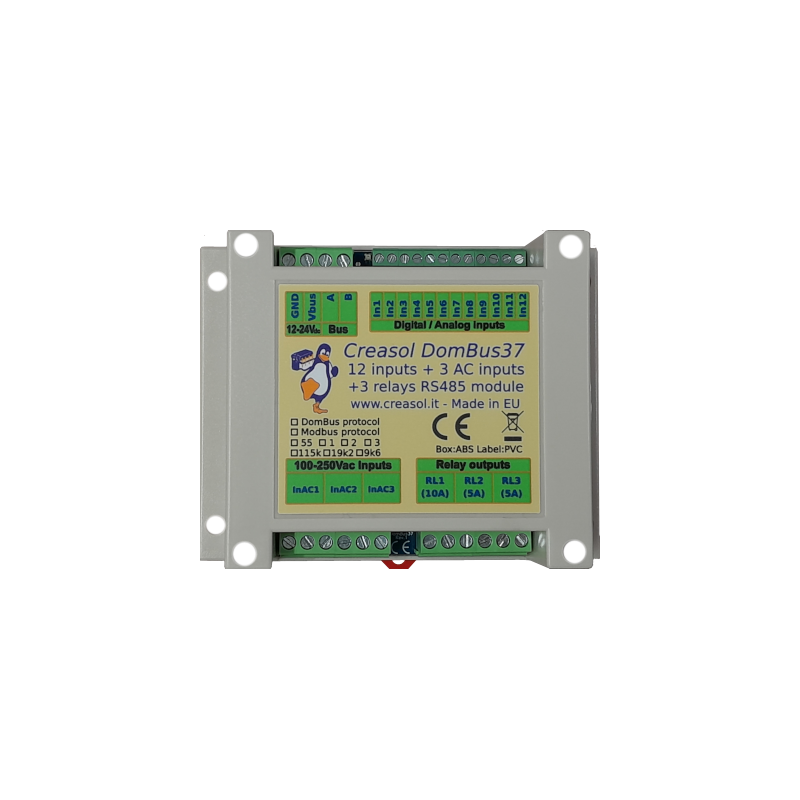
Creasol DomBusTH - ierīce Domoticz ar temperatūras un mitruma sensoriem, 4 ieejām, 2 izejām, 3 gaismas diodēm
- Izpārdošana!
- -25%
Email: store@creasol.it - Telegram: CreasolTech - Whatsapp: +393283730010
Prioritārais pasts: ātri un lēti - Express kurjer
Pirms preču atgriešanas sazinieties ar mums!

DIN RAIL modulis, 115x90x40mm, atbalsta abusDomBusunModbus RTU protokoli.
Tā integrējas12x zemsprieguma analogās/digitālās ieejas, 3x releju izejas, 3x 115V/230V ieejas. Pēc izvēles tas spēj kontrolēt un uzraudzīt barošanas avotu, kas tiek padots aapsardzes signalizācijas ārējā sirēna.Noder, lai izveidotu apsardzes signalizācijas sistēmas ar mājas automatizācijas kontrolieriem, piemēram, Domoticz, Home Assistant, OpenHAB, ...
 Pilns atbalsts: lielāko daļu produktu izstrādājam mēs!
Pilns atbalsts: lielāko daļu produktu izstrādājam mēs!
Email: store@creasol.it - Telegram: CreasolTech - Whatsapp: +393283730010
 Pasūtījumi tiek nosūtīti 1 darba dienas laikā
Pasūtījumi tiek nosūtīti 1 darba dienas laikā
Prioritārais pasts: ātri un lēti - Express kurjer
 24 mēnešu garantija, ērta atgriešana/atmaksa
24 mēnešu garantija, ērta atgriešana/atmaksa
Pirms preču atgriešanas sazinieties ar mums!
*** Pilnīga informācija plksthttps://www.creasol.it/DomBus37***
Creasol DomBus37irDIN RAIL modulis, 115x90x40mm, atbalsta abusDomBusunModbus RTU protokoli.
Tā integrējas12x zemsprieguma analogās/digitālās ieejas, 3x releju izejas, 3x 115V/230V ieejas. Pēc izvēles tas spēj kontrolēt un uzraudzīt barošanas avotu, kas tiek padots aapsardzes signalizācijas ārējā sirēna.
To var savienot ar mājas automatizācijas kontrolieri, izmantojot RS485 seriālo kopni (4 vadi, 2 12/24V barošanas avotam un 2 datu pārraidei ar ātrumu 115 200 bps).
Tāpat kā citas DomBus ierīces,DomBus37 ir izstrādāts tā, lai patērētu zemu jaudu, būtu uzticams, pilnībā konfigurējams un viegli lietojams. Katrs ievades ports ir pilnībā konfigurējams, piemēram, kā analogā vai digitālā ieeja, dvīņu poga (dubultā poga savienota ar vienu portu), skaitītājs, zummers, NTC 10k, ... Analogie porti spēj atšifrēt vienu, dubultu, trīskāršu, četrkāršu balansētu. trauksmes sensori.
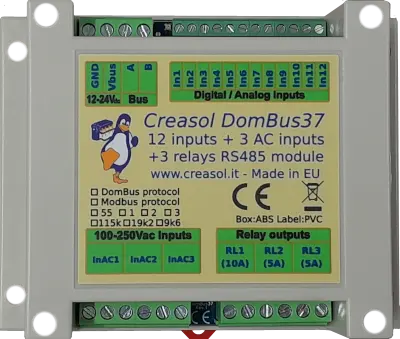
Pilnīga informācija un pieteikuma piezīmes plksthttps://www.creasol.it/DomBus37
Noklusējuma adrese: 0xff37
| Port# | Vārds | Iespējas | Noklusējuma konfigurācija | Apraksts |
| 1 | IN1 | IN_DIGITAL, IN_DIGITAL_PULLDOWN, IN_ANALOG, IN_TWINBUTTON, IN_COUNTER | IN_DIGITAL |
Ievade ar izvēles 10 k izvilkšanu (pcb džemperis) un iekšējo nolaižamo funkciju (aktivizēta, ja tā ir konfigurēta kā IN_DIGITAL_PULLDOWN). Ja tas ir savienots ar vienu spiedpogu slēdzi vai trauksmes sensoru, parasti ir GND (ja slēdzis ir IESLĒGTS, tam ir jāsavieno ports ar GND). Var savienot ar ārējo NTC termistoru (gaisa vai ūdens temperatūras sensoru). |
| 2 | IN2 | IN_DIGITAL, IN_DIGITAL_PULLDOWN, IN_ANALOG, IN_TWINBUTTON, IN_COUNTER | IN_DIGITAL |
Ievade ar izvēles 10 k izvilkšanu (pcb džemperis) un iekšējo nolaižamo funkciju (aktivizēta, ja tā ir konfigurēta kā IN_DIGITAL_PULLDOWN). Ja tas ir savienots ar vienu spiedpogu slēdzi vai trauksmes sensoru, parasti ir GND(kad slēdzis ir IESLĒGTS, tam ir jāsavieno ports ar GND). Var savienot ar ārējo NTC termistoru (gaisa vai ūdens temperatūras sensoru). |
| 3 | IN3 | IN_DIGITAL, IN_DIGITAL_PULLDOWN, IN_ANALOG, IN_TWINBUTTON, IN_COUNTER | IN_DIGITAL |
Ievade ar izvēles 10 k izvilkšanu (pcb džemperis) un iekšējo nolaižamo funkciju (aktivizēta, ja tā ir konfigurēta kā IN_DIGITAL_PULLDOWN). Ja tas ir savienots ar vienu spiedpogu slēdzi vai trauksmes sensoru, parasti ir GND (ja slēdzis ir IESLĒGTS, tam ir jāsavieno ports ar GND). Var savienot ar ārējo NTC termistoru (gaisa vai ūdens temperatūras sensoru). |
| 4 | IN4 | IN_DIGITAL, IN_DIGITAL_PULLDOWN, IN_ANALOG, IN_TWINBUTTON, IN_COUNTER | IN_DIGITAL |
Ievade ar izvēles 10 k izvilkšanu (pcb džemperis) un iekšējo nolaižamo funkciju (aktivizēta, ja tā ir konfigurēta kā IN_DIGITAL_PULLDOWN). Ja tas ir savienots ar vienu spiedpogu slēdzi vai trauksmes sensoru, parasti ir GND (ja slēdzis ir IESLĒGTS, tam ir jāsavieno ports ar GND). Var savienot ar ārējo NTC termistoru(gaisa vai ūdens temperatūras sensors). |
| 5 | IN5 | IN_DIGITAL, IN_DIGITAL_PULLDOWN, IN_ANALOG, IN_TWINBUTTON, IN_COUNTER | IN_DIGITAL |
Ievade ar izvēles 10 k izvilkšanu (pcb džemperis) un iekšējo nolaižamo funkciju (aktivizēta, ja tā ir konfigurēta kā IN_DIGITAL_PULLDOWN). Ja tas ir savienots ar vienu spiedpogu slēdzi vai trauksmes sensoru, parasti ir GND (ja slēdzis ir IESLĒGTS, tam ir jāsavieno ports ar GND). Var savienot ar ārējo NTC termistoru (gaisa vai ūdens temperatūras sensoru). |
| 6 | IN6 | IN_DIGITAL, IN_DIGITAL_PULLDOWN, IN_ANALOG, IN_TWINBUTTON, IN_COUNTER | IN_DIGITAL |
Ievade ar izvēles 10 k izvilkšanu (pcb džemperis) un iekšējo nolaižamo funkciju (aktivizēta, ja tā ir konfigurēta kā IN_DIGITAL_PULLDOWN). Ja tas ir savienots ar vienu spiedpogu slēdzi vai trauksmes sensoru, parasti ir GND (ja slēdzis ir IESLĒGTS, tam ir jāsavieno ports ar GND). Var savienot ar ārējo NTC termistoru (gaisa vai ūdens temperatūras sensoru). |
| 7 | IN7 | IN_DIGITAL, IN_DIGITAL_PULLDOWN, IN_ANALOG, IN_TWINBUTTON, IN_COUNTER | IN_DIGITAL |
Ievade ar izvēles 10 k izvilkšanu (pcb džemperis) un iekšējo nolaižamo funkciju (aktivizēta, ja tā ir konfigurēta kā IN_DIGITAL_PULLDOWN). Ja tas ir savienots ar vienu spiedpogu slēdzi vai trauksmes sensoru, parasti ir GND (ja slēdzis ir ON, tam ir jāsavieno ports ar GND). Var savienot ar ārējo NTC termistoru (gaisa vai ūdens temperatūras sensoru). |
| 8 | IN8 | IN_DIGITAL, IN_DIGITAL_PULLDOWN, IN_ANALOG, IN_TWINBUTTON, IN_COUNTER | IN_DIGITAL |
Ievade ar izvēles 10 k izvilkšanu (pcb džemperis) un iekšējo nolaižamo funkciju (aktivizēta, ja tā ir konfigurēta kā IN_DIGITAL_PULLDOWN). Ja tas ir savienots ar vienu spiedpogu slēdzi vai trauksmes sensoru, parasti ir GND (ja slēdzis ir IESLĒGTS, tam ir jāsavieno ports ar GND). Var savienot ar ārējo NTC termistoru (gaisa vai ūdens temperatūras sensoru). |
| 9 | IN9 | IN_DIGITAL, IN_DIGITAL_PULLDOWN, IN_ANALOG, IN_TWINBUTTON, IN_COUNTER | IN_DIGITAL |
Ievade ar izvēles 10 k izvilkšanu (pcb džemperis) un iekšējo nolaižamo funkciju (aktivizēta, ja tā ir konfigurēta kā IN_DIGITAL_PULLDOWN). Ja tas ir savienots ar vienu spiedpogu slēdzi vai trauksmes sensoru, parasti ir GND (ja slēdzis ir IESLĒGTS, tam ir jāsavieno ports ar GND). Var savienot ar ārējo NTC termistoru (gaisa vai ūdens temperatūras sensoru). |
| 10 | IN10 | IN_DIGITAL, IN_DIGITAL_PULLDOWN, IN_ANALOG, IN_TWINBUTTON, IN_COUNTER | IN_DIGITAL |
Ievade ar izvēles 10 k izvilkšanu (pcb džemperis) un iekšējo nolaižamo funkciju (aktivizēta, ja tā ir konfigurēta kā IN_DIGITAL_PULLDOWN). Ja tas ir savienots ar vienu spiedpogu slēdzi vai trauksmes sensoru, parasti ir GND (ja slēdzis ir IESLĒGTS, tam ir jāsavieno ports ar GND). Var savienot ar ārējo NTC termistoru (gaisa vai ūdens temperatūras sensoru). |
| 11 | IN11 | IN_DIGITAL, IN_DIGITAL_PULLDOWN, IN_ANALOG, IN_TWINBUTTON, IN_COUNTER | IN_DIGITAL |
Ievade ar izvēles 10 k izvilkšanu (pcb džemperis) un iekšējo nolaižamo funkciju (aktivizēta, ja tā ir konfigurēta kā IN_DIGITAL_PULLDOWN). Ja tas ir savienots ar vienu spiedpogu slēdzi vai trauksmes sensoru, parasti ir GND (ja slēdzis ir IESLĒGTS, tam ir jāsavieno ports ar GND). Var savienot ar ārējo NTC termistoru (gaisa vai ūdens temperatūras sensoru). |
| 12 | IN12 | IN_DIGITAL, IN_DIGITAL_PULLDOWN, IN_ANALOG, IN_TWINBUTTON, IN_COUNTER, CUSTOM | IN_DIGITAL |
Ievade ar izvēles 10 k izvilkšanu (pcb džemperis) un iekšējo nolaižamo funkciju (aktivizēta, ja tā ir konfigurēta kā IN_DIGITAL_PULLDOWN). Ja tas ir savienots ar vienu spiedpogu slēdzi vai trauksmes sensoru, parasti ir GND (ja slēdzis ir IESLĒGTS, tam ir jāsavieno ports ar GND). Var savienot ar ārējo NTC termistoru (gaisa vai ūdens temperatūras sensoru). |
| 13 | INAC1 | IN_AC, IN_COUNTER | IN_AC | Optoizolētsieeja, ko var savienot ar automātisko slēdzi (lai paziņotu par strāvas padeves pārtraukumiem, īpaši ledusskapjiem un siltumsūkņiem), PIR ar 230 V izeju (lai uzraudzītu klātbūtni), gaismai un ierīcēm (lai uzraudzītu, kad gaisma vai ierīces ir IESLĒGTS). |
| 14 | INAC2 | IN_AC, IN_COUNTER | IN_AC | Optoizolēta ieeja, ko var savienot ar automātisko slēdzi (lai paziņotu par strāvas padeves pārtraukumiem, īpaši ledusskapjiem un siltumsūkņiem), PIR ar 230 V izeju (lai uzraudzītu klātbūtni), gaismai un ierīcēm (lai uzraudzītu, kad gaisma vai ierīces ir IESLĒGTS). |
| 15 | INAC3 | IN_AC, IN_COUNTER | IN_AC | Optoizolēta ieeja, ko var savienot ar automātisko slēdzi (lai paziņotu par strāvas padeves pārtraukumiem, īpaši ledusskapjiem un siltumsūkņiem), PIR ar 230 V izeju (lai uzraudzītu klātbūtni), gaismai un ierīcēm (lai uzraudzītu, kad gaisma vai ierīces ir IESLĒGTS). |
| 16 | RL1 | OUT_DIGITAL, OUT_RELAY_LP, OUT_BLIND, OUT_FLASH | OUT_RELAY_LP | SPST releja izeja, BEZ kontakta, 10A 250Vac vai 30Vdc izejas iespēja. Releja kontakts ir aizsargāts ar varistoru. |
| 17 | RL2 | OUT_DIGITAL, OUT_RELAY_LP, OUT_BLIND, OUT_FLASH | OUT_RELAY_LP | SPST releja izeja, BEZ kontakta, 5A 250Vac vai 30Vdc izejas iespēja. Releja kontakts ir aizsargāts ar varistoru. |
| 18 | RL3 | OUT_DIGITAL, OUT_RELAY_LP, OUT_BLIND(1),OUT_FLASH | OUT_RELAY_LP | SPST releja izeja, BEZ kontakta, 5A 250Vac vai 30Vdc izejas iespēja. Releja kontakts ir aizsargāts ar varistoru. |
| 19 | VBus | PIELĀGOJUMS | PIELĀGOJUMS | 12-24V kopnes spriegums, mW (piemēram, 13508 13,508mV) |
| 20 | S.Volt | PIELĀGOJUMS | PIELĀGOJUMS | Spriegums uz sirēnas porta (IN12 spaiļu bloks) mV. Lai iegūtu papildinformāciju, skatiet tālāk esošo rindkopu. |
| 21 | S.Curr | PIELĀGOJUMS | PIELĀGOJUMS | Strāva uz sirēnas porta (IN12 spaiļu bloks) mA. Lai iegūtu papildinformāciju, skatiet tālāk esošo rindkopu. |
| 22 | S.On | PIELĀGOJUMS | PIELĀGOJUMS | Ieslēgšanas/izslēgšanas entītija, lai iespējotu/atspējotu barošanas padevi sirēnai. Lai iegūtu papildinformāciju, skatiet tālāk esošo rindkopu. |
| 23 | S.Valsts | PIELĀGOJUMS | PIELĀGOJUMS | Sirēnas jaudas statuss. Lai iegūtu papildinformāciju, skatiet tālāk esošo rindkopu. |
(1): var izmantot kā BLIND izeju, lai atvērtu žalūziju/aizkaru, bet tikai iepriekšējo portu var konfigurēt Domoticz kā OUT_BLINDjo, konfigurējot kā OUT_BLIND, DomBus ierīce automātiski konfigurē nākamo portu, lai vadītu releju atvērtā virzienā.
The following video shows a presentation of some domotic modules designed and produced in Italy by Creasol to make a reliable, easy and power-optimized home automation system.
The next video shows our Smart EVSE module that can be used to charge the electric car by using only solar power, or adding 25/50/75/100% of available power from the electrical grid.
Our industrial and home automation modules are designed to be
Modules are available in two version:
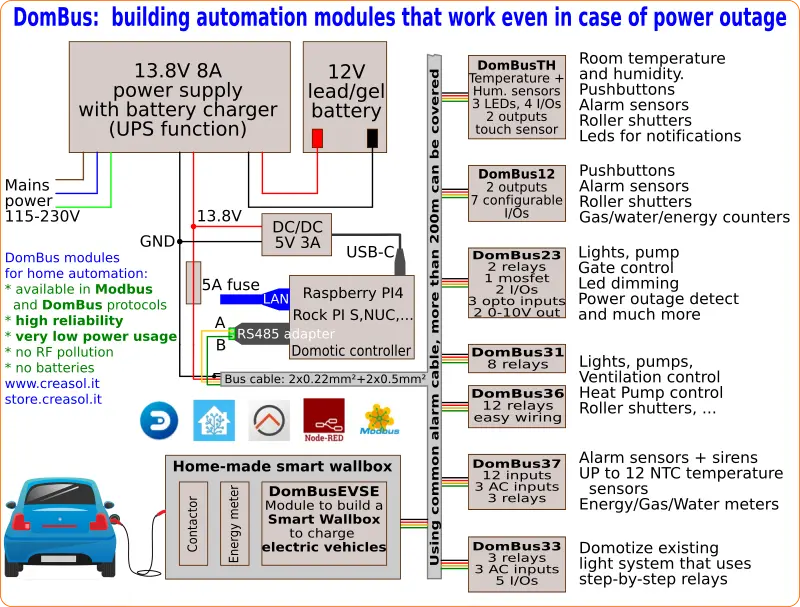
Store website - Information website
For our products we can offer FULL SUPPORT and CUSTOMIZATION: please contact us by Email or Telegram
 Complete solution to make a Smart EVSE, charging the electric vehicle using only energy from renewable source (photovoltaic, wind, ...), or adding 25-50-75-100% of available power from the grid.
Complete solution to make a Smart EVSE, charging the electric vehicle using only energy from renewable source (photovoltaic, wind, ...), or adding 25-50-75-100% of available power from the grid.
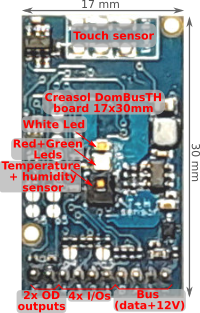 Compact board, 32x17mm, to be installed on blank cover with a 4mm hole in the middle, to exchange air for the relative humidity sensor. It can be installed in every room to monitor temperature and humidity, check alarm sensors, control blind motor UP/DOWN, send notifications (using red and green leds) and activate white led in case of power outage.
Compact board, 32x17mm, to be installed on blank cover with a 4mm hole in the middle, to exchange air for the relative humidity sensor. It can be installed in every room to monitor temperature and humidity, check alarm sensors, control blind motor UP/DOWN, send notifications (using red and green leds) and activate white led in case of power outage.
Includes:
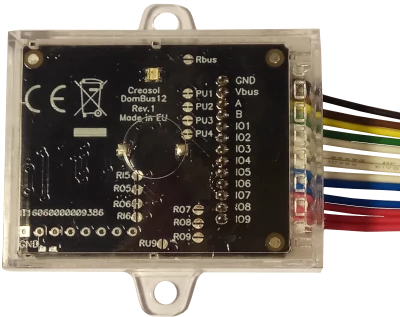 Very compact, versatile and cost-effective module with 9 ports. Each port can be configured by software as:
Very compact, versatile and cost-effective module with 9 ports. Each port can be configured by software as:
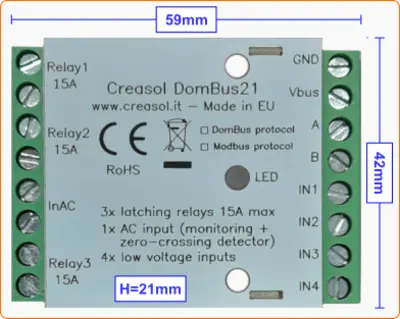 Very low power consumption module designed to enable up to 3 high power loads, up to 15A (3kW).
Very low power consumption module designed to enable up to 3 high power loads, up to 15A (3kW).
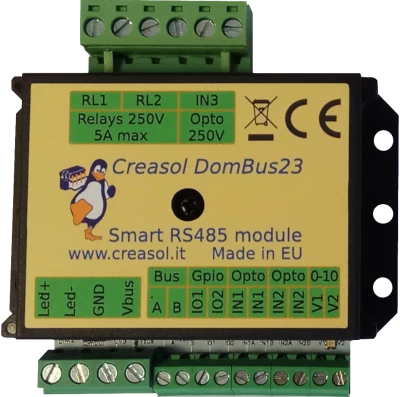 Versatile module designed to control gate or garage door.
Versatile module designed to control gate or garage door.
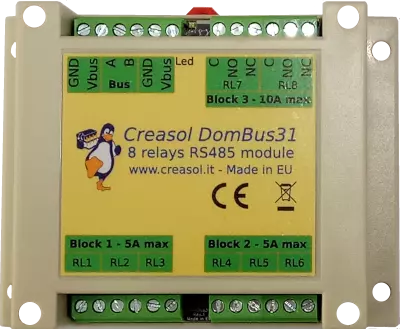 DIN rail low profile module, with 8 relays and very low power consumption:
DIN rail low profile module, with 8 relays and very low power consumption:
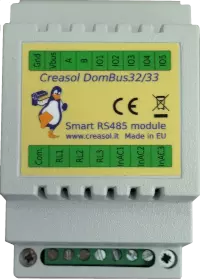 Versatile module with 230V inputs and outputs, and 5 low voltage I/Os.
Versatile module with 230V inputs and outputs, and 5 low voltage I/Os.
 Module designed to control 3 lights already existing and actually controlled by 230V pushbuttons and step-by-step relays. In this way each light can be activated by existing pushbuttons, and by the domotic controller.
Module designed to control 3 lights already existing and actually controlled by 230V pushbuttons and step-by-step relays. In this way each light can be activated by existing pushbuttons, and by the domotic controller.
Each relay can toggle the existing step-relay, switching the light On/Off. The optoisolator monitors the light status. The 5 I/Os can be connected to pushbuttons to activate or deactivate one or all lights.
 DIN rail module, low profile, with 12 relays outputs and very low power consumption.
DIN rail module, low profile, with 12 relays outputs and very low power consumption.
 Module designed to be connected to alarm sensors (magnetc contact sensors, PIRs, tampers): it's able to monitor mains power supply (power outage / blackout) and also have 3 relays outputs.
Module designed to be connected to alarm sensors (magnetc contact sensors, PIRs, tampers): it's able to monitor mains power supply (power outage / blackout) and also have 3 relays outputs.
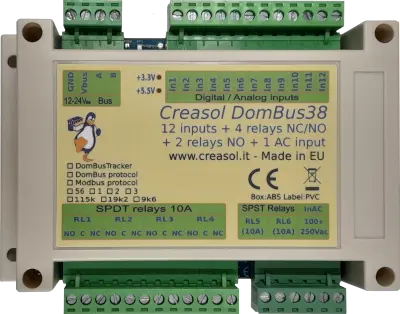 DIN rail module designed for burglar alarm system.
DIN rail module designed for burglar alarm system.
![]() DIN rail module that control azimuth + elevation/tilt motors of a sun tracker, to maximize photovoltaic energy production during the day and seasons.
DIN rail module that control azimuth + elevation/tilt motors of a sun tracker, to maximize photovoltaic energy production during the day and seasons.
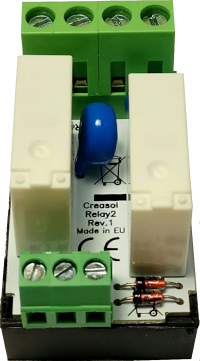 Simple module with 2 relays, to be used with DomBus modules or other electronic boards with open-collector or open-drain outputs
Simple module with 2 relays, to be used with DomBus modules or other electronic boards with open-collector or open-drain outputs
 IoT board designed for NodeMCU v3 board using ESP8266 WiFi microcontroller
IoT board designed for NodeMCU v3 board using ESP8266 WiFi microcontroller